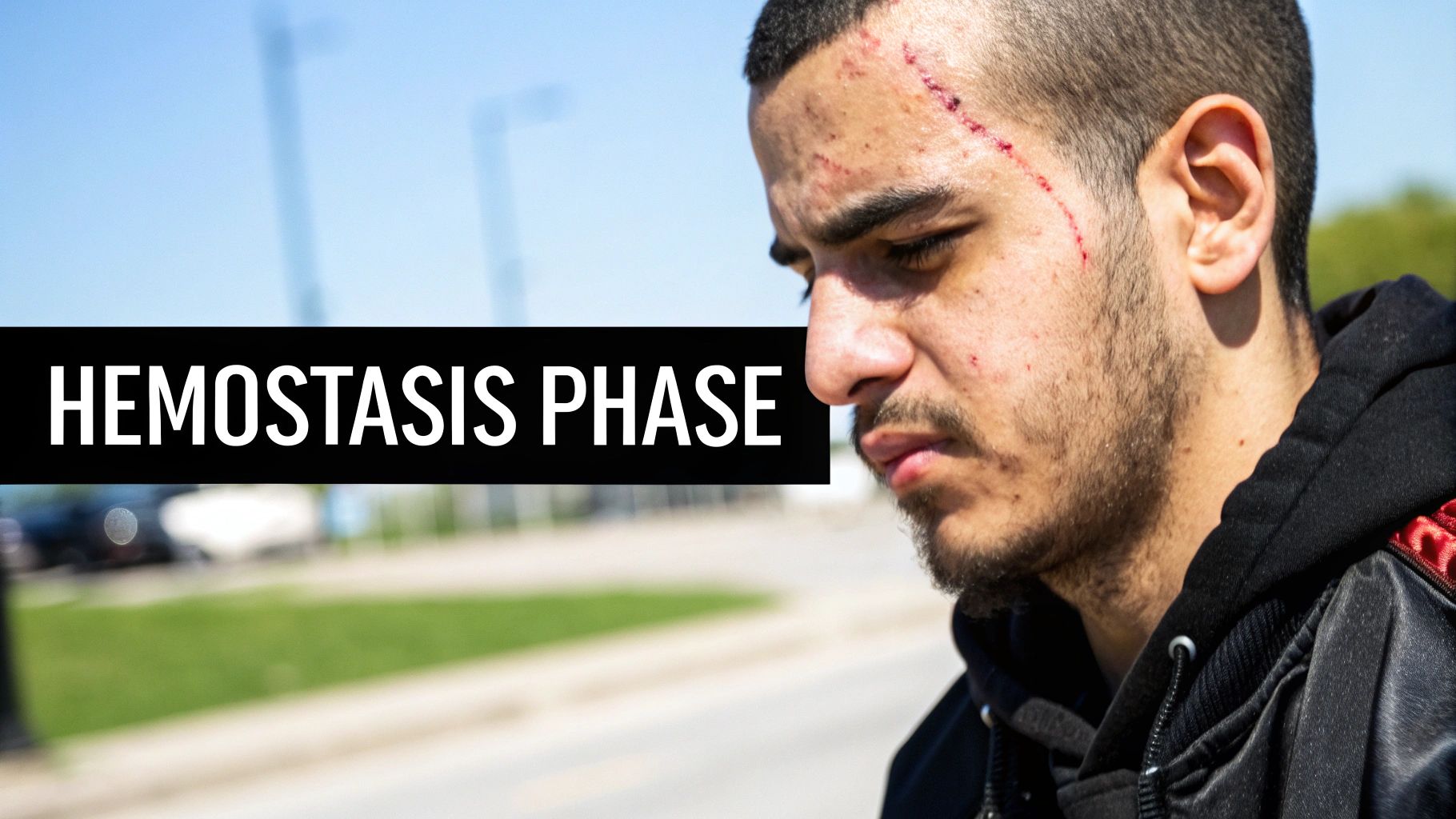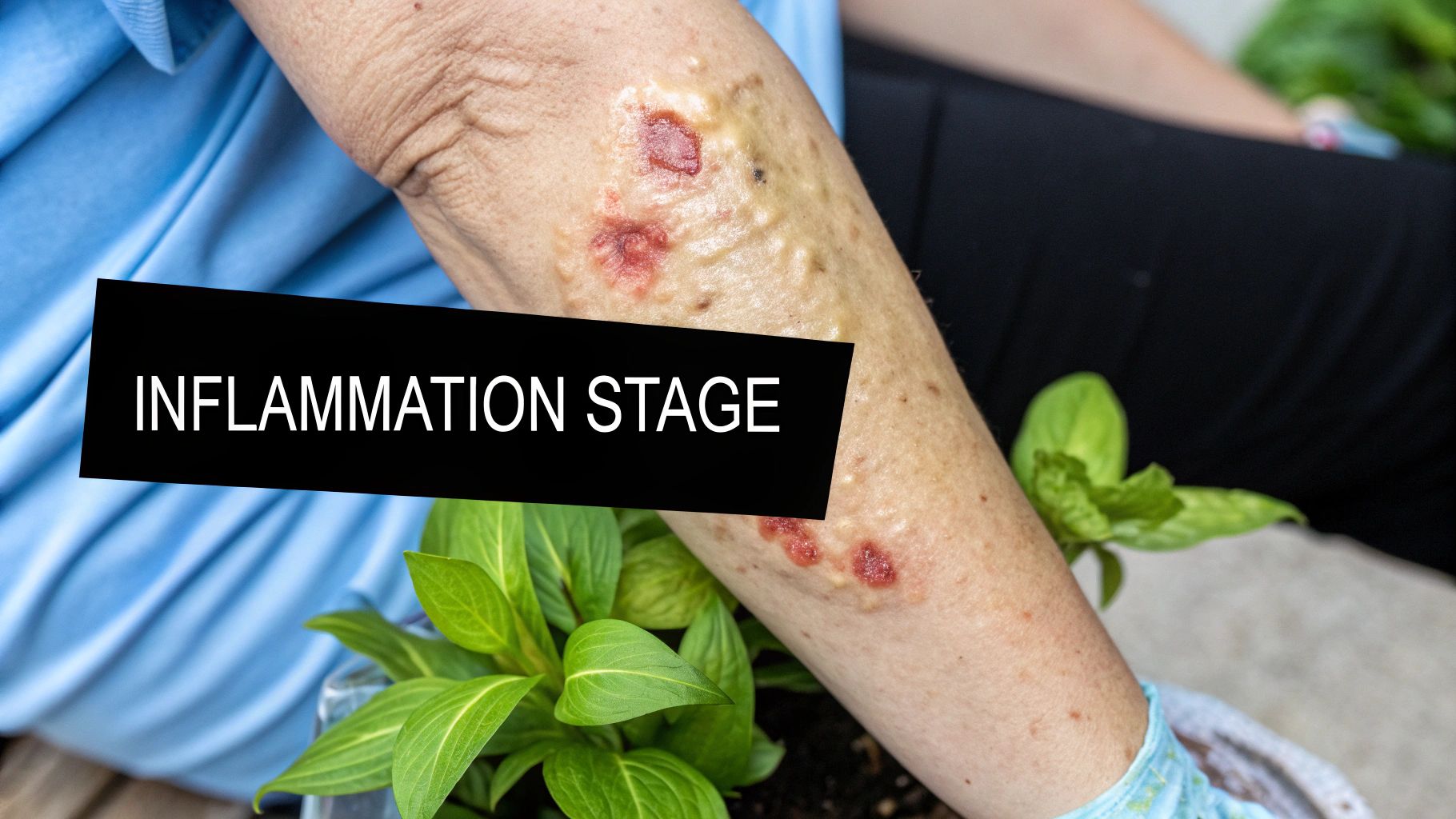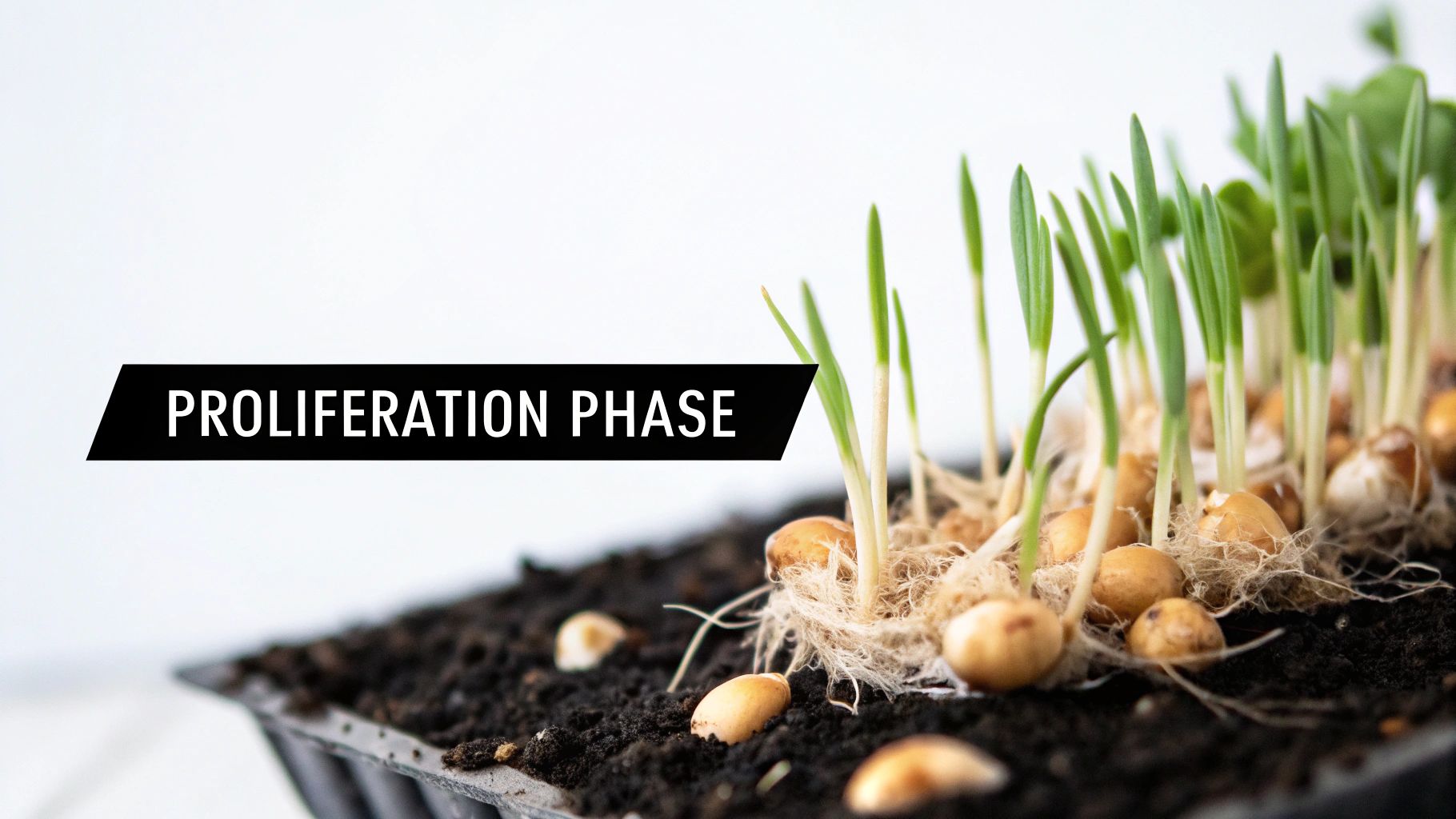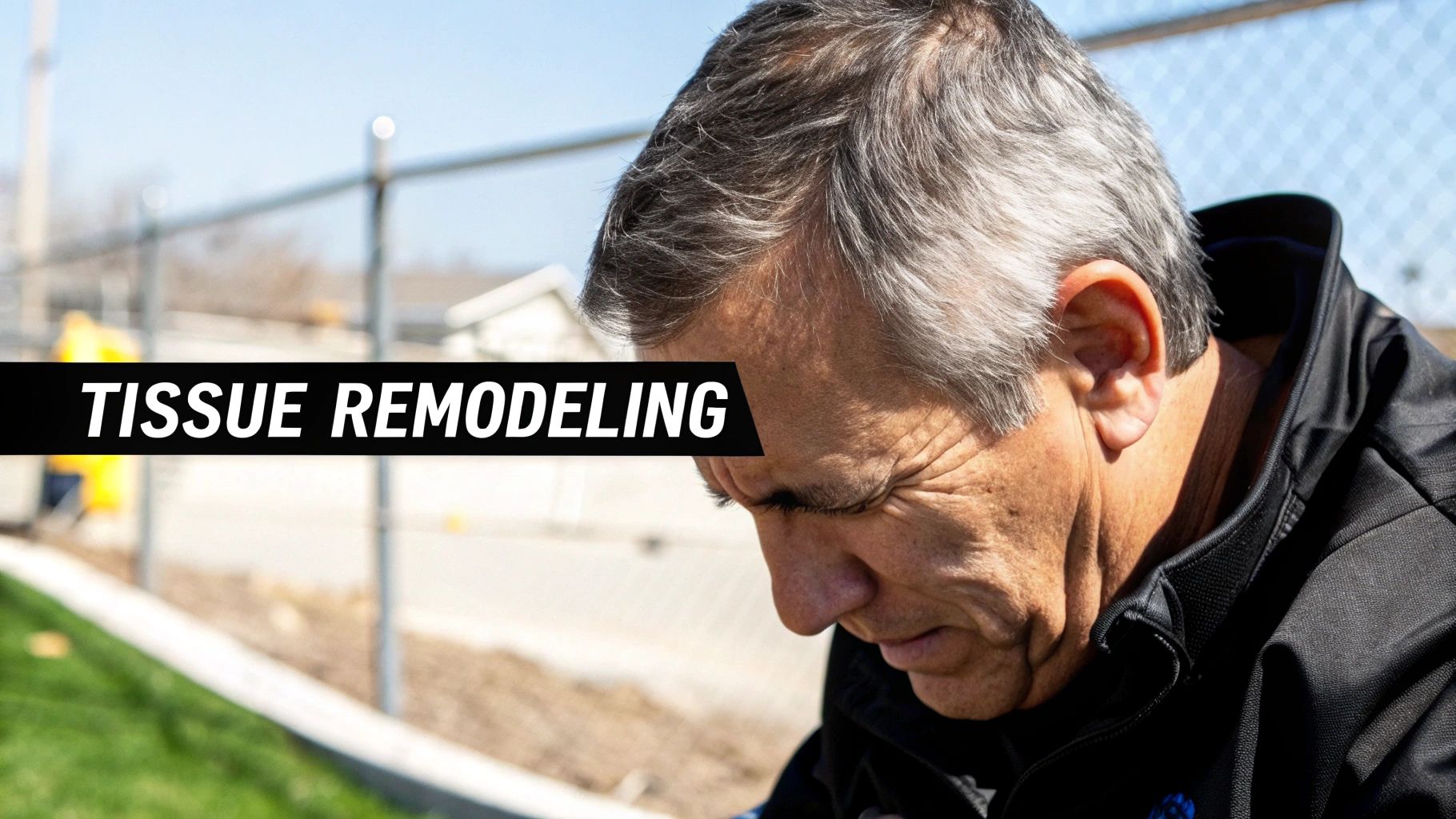The Fascinating Science Behind Wound Healing
Our skin, a remarkable protective shield, is surprisingly resilient. When injured, a complex process kicks in to repair the damage: wound healing. This isn’t a single action, but a precisely timed series of stages working together. Understanding these wound healing stages is essential for a smooth recovery and minimizing any potential problems.
The Four Main Stages of Wound Healing
Think of wound healing like constructing a building. First, the site needs securing (hemostasis). Then, debris is cleared, and the foundation is laid (inflammation). Next, the building’s structure takes shape (proliferation). Finally, the finishing touches are applied, making it functional (remodeling). Just like a building project, your body utilizes different “specialists” – cells and processes – at each phase.
These stages are a complex interplay of four distinct phases: hemostasis, inflammation, proliferation, and remodeling. Hemostasis, the immediate post-injury phase, lasts about two days. Blood vessels constrict and clotting begins to stop bleeding. Inflammation follows, lasting up to seven days in acute wounds. White blood cells and enzymes clear bacteria and debris.
The proliferation phase, lasting from four days to several weeks, focuses on tissue growth and wound coverage. Lastly, remodeling, which can take months or even years, strengthens and improves the new scar tissue’s flexibility. This entire process is vital for effective healing and is influenced by factors like nutrition, sleep, and proper wound care. Explore this topic further
Understanding Each Phase
Understanding each stage helps you recognize what’s happening beneath your skin. During hemostasis, you’ll see the bleeding stop as a clot forms. This crucial first step sets the stage for the following phases.
The inflammation stage is often marked by redness, swelling, and warmth, indicating your body is fighting infection and clearing debris. While some discomfort is normal, excessive or prolonged inflammation could signal a problem.
The proliferation phase is where the real action happens. New tissue fills the wound, and you’ll see visible signs of healing. This stage prepares the wound for the final remodeling phase.
Remodeling, the longest stage, is where the scar tissue strengthens and matures. While the wound may look healed on the surface, the underlying tissue continues remodeling for months, sometimes years. This highlights the importance of long-term care even after the initial injury seems resolved.
Hemostasis: Your Body’s Brilliant First Response

Immediately after an injury, your body jumps into action, starting the first phase of wound healing: hemostasis. This vital process stops bleeding within seconds and sets the stage for a healthy recovery. It’s a prime example of your body’s natural ability to protect and heal itself. This stage is especially important for those with bleeding disorders or taking medications like blood thinners.
The Clotting Cascade: A Symphony of Cells
Hemostasis is a complex chain reaction. The first responders are your blood vessels, which constrict to reduce blood flow to the injured area. This vasoconstriction minimizes blood loss and focuses repair efforts.
This then allows platelets, small cells in your blood, to arrive at the scene. These normally inactive cells become sticky and clump together at the injury site, forming a platelet plug. This initial plug acts like a temporary bandage.
The next step involves the coagulation cascade. This complex process uses proteins to build a stable blood clot. These proteins work like a construction crew, strengthening the platelet plug to prevent further bleeding. The final clot, made of fibrin and trapped blood cells, protects the wound and allows healing to begin.
To help visualize this process, let’s take a look at the following timeline:
To help understand this complex process, the table below details the steps involved in hemostasis:
Hemostasis Timeline: What Happens When You’re Wounded
| Time After Injury | Biological Event | What You May Notice |
|---|---|---|
| Seconds | Blood vessel constriction | |
| Seconds to Minutes | Platelet plug formation | |
| Minutes | Coagulation cascade begins | |
| Minutes to Hours | Stable clot formation | Visible clot, redness, slight swelling |
This table outlines the key events in hemostasis, from the initial injury to the formation of a stable clot. The quick response of your body’s systems emphasizes the importance of hemostasis in wound healing.
Recognizing Normal Hemostasis
Understanding normal hemostasis helps you monitor wounds and identify potential problems. Bleeding typically slows significantly within minutes of injury, with a visible clot forming. Slight redness or swelling is also normal.
However, prolonged bleeding, excessive bruising, or continuous oozing may indicate a problem. This is especially important for those with bleeding disorders or taking blood thinners. If you experience any of these issues, seek medical attention. Rapid Wound Care specializes in wound assessment and management. Learn how Rapid Wound Care can help.
Knowing how hemostasis works lets you spot normal healing and potential warning signs. This enables timely treatment and better healing outcomes, leading to a faster, smoother recovery.
Inflammation: The Crucial Cleanup Phase

Following hemostasis, the next critical stage of wound healing is inflammation. This phase, sometimes associated with discomfort, is a vital part of recovery. Inflammation signals that your body is actively cleaning the wound and preparing for rebuilding. In acute wounds, this phase typically lasts up to seven days.
The Body’s Cleanup Crew in Action
Inflammation brings noticeable changes around the wound. Redness, swelling, and warmth are common, indicating increased blood flow. This delivers essential cells and nutrients to the injury site.
Specialized white blood cells, like macrophages and neutrophils, drive these changes. They act as a cleanup crew, removing bacteria, damaged tissue, and debris. These cells clear the way for new tissue growth.
Recognizing Healthy vs. Problematic Inflammation
A certain amount of inflammation is normal and necessary for wound healing. However, excessive or prolonged inflammation can signal a problem. Increased pain, excessive pus, or a foul odor can indicate infection.
Chronic inflammation, lasting longer than a week, can also hinder healing. This can occur in individuals with diabetes or weakened immune systems. Understanding inflammation is particularly important for these individuals. If you have concerns, seek professional advice from a wound care specialist. Rapid Wound Care offers personalized assessments and treatment for various wound types.
Supporting Healthy Inflammation
While some discomfort is expected, there are ways to support the inflammation process. Proper wound care, like keeping the wound clean and covered, is crucial. This prevents infection and creates a moist healing environment.
Nutrition and rest also play significant roles. A balanced diet provides the necessary building blocks for tissue repair, while adequate sleep allows your body to focus on healing.
Transitioning to the Next Stage
As inflammation subsides, redness, swelling, and pain will decrease. This indicates the cleanup is finishing, and the wound is entering the proliferation phase. This next stage focuses on rebuilding new tissue, marking a significant step in the healing process.
Proliferation: Where Healing Magic Happens

After the initial inflammation cleanup, the wound enters the proliferation phase. This is the main construction phase, where the focus shifts to rebuilding new tissue. Think of it like building a house: this stage is the framing and drywall, creating the underlying structure. This phase typically lasts from four days to several weeks, depending on the wound’s severity.
Building the Foundation: New Tissue Growth
Proliferation involves creating new cells and blood vessels. Specialized cells called fibroblasts produce collagen, a protein that provides the structural framework for new tissue. This collagen acts as scaffolding, giving the wound support and structure.
At the same time, new blood vessels develop through angiogenesis. These vessels deliver oxygen and nutrients to the growing tissue, fueling the rebuilding process. The wound begins to fill with granulation tissue, a reddish, bumpy tissue rich in these new blood vessels. This granulation tissue is a positive sign of healing.
Closing the Gap: Epithelialization
As new tissue fills the wound, skin cells at the wound edges (called epithelial cells) begin migrating across the wound’s surface. This process, called epithelialization, closes the wound like a zipper, forming a new protective barrier. You might see this as a pink or light-colored layer over the granulation tissue – a visible sign of closure.
Wound contraction also occurs, further reducing the wound’s size. Specialized cells called myofibroblasts pull the wound edges together. This can sometimes cause itching or tightness, which is a normal indication of progress. This continues until the wound is fully closed.
Supporting Proliferation: Nutrition and Wound Care
Several factors influence proliferation. Proper nutrition is critical, providing the necessary building blocks for new tissue. A diet rich in protein, vitamins A and C, and zinc supports collagen production and cell growth.
Effective wound care is also essential. Keeping the wound moist and protected with appropriate dressings helps promote cell migration and tissue regeneration. In contrast, chronic wounds present a global challenge, often requiring extended healing times – exceeding the typical 4–12 weeks seen with acute wounds. These chronic wounds also create a significant economic burden, with Medicare expenses estimated at $96.8 billion in 2014 in the United States. Innovations like using machine learning to predict healing timelines (based on factors like patient demographics and wound characteristics) are showing promise in improving outcomes.
Transitioning to Remodeling: The Final Stage

Once the wound is closed, the proliferation phase ends, and the remodeling stage begins. This final phase strengthens and refines the new scar tissue. While the wound might look healed on the surface, the underlying tissue continues to change for months or even years, highlighting the importance of this final stage in the wound healing stages.
Remodeling: The Secret Life of Your Scar
This final stage of wound healing, remodeling, requires a long-term commitment. Even after the wound seems closed on the surface, the underlying tissue continues changing, sometimes for years. This is where the scar gains strength and flexibility, and its appearance gradually improves.
Collagen: The Building Block of Scars
Remodeling focuses on collagen, a strong, fibrous protein. During the earlier proliferation phase, collagen fibers are quickly produced to close the wound. In remodeling, these fibers are reorganized, broken down, and rebuilt in a more organized, cross-linked structure. This process makes the scar tissue stronger. At first, a scar may only have 15% of normal skin strength. Remodeling can eventually increase this to 80%.
Maturation and Refinement: A Long-Term Process
Remodeling happens gradually. Over time, the scar fades, flattens, and becomes less noticeable. The prominent blood vessels from the proliferation phase regress, reducing redness. The scar tissue also softens and becomes more flexible.
The final appearance of a scar varies greatly. Factors such as genetics, wound depth and location, and how well the wound was cared for in earlier healing stages all play a role.
Hypertrophic Scarring: A Specific Challenge
Hypertrophic scarring, common after burns, involves excessive collagen, resulting in raised, thick scars. Treatments like scar massage can improve these scars by reducing height, redness, and stiffness. This ultimately enhances both function and appearance. A systematic review of scar massage for hypertrophic burn scars, involving over 250 participants, showed notable improvements in pain, depression, and scar characteristics. Discover more insights about hypertrophic scarring
More research, particularly rigorous clinical trials, is needed to establish best practices for managing hypertrophic scars.
Supporting Optimal Remodeling: Evidence-Based Approaches
While remodeling happens naturally, certain interventions can optimize scar formation. Scar massage, using gentle, circular motions, can break down excess collagen and improve flexibility. Silicone sheets or silicone gels can hydrate scar tissue, reduce redness, and flatten raised scars.
Other interventions, such as pressure therapy and laser treatments, may help certain scar types. Consult a healthcare professional at Rapid Wound Care to determine the best approach for your needs.
Realistic Expectations and Long-Term Care
It’s crucial to have realistic expectations about scar remodeling. Scars rarely disappear completely. However, with proper care and time, most scars improve significantly in appearance and function.
Long-term care is essential. Protecting the scar from the sun with sunscreen prevents hyperpigmentation (darkening). Maintaining good skin hydration and overall health also contributes to positive results. During the proliferation stage, regenerative medicine techniques like cell-based therapy can be employed to accelerate healing.
Understanding the remodeling phase allows you to manage your expectations and take proactive steps in your healing journey. While some aspects are beyond our control, knowing what to expect and how to support this final stage leads to better scar outcomes and improved quality of life.
Healing Accelerators and Barriers: What Really Works
Why do some wounds heal quickly, while others seem to linger? This section delves into the factors that truly impact the stages of wound healing. We’ll explore which approaches genuinely support tissue repair, examining how everyday elements, like nutrition and sleep, influence recovery. We’ll also discuss often-overlooked factors, such as hydration and blood sugar levels, and their significant effects on healing outcomes.
Nutrition: Fueling the Repair Process
Proper nutrition provides the essential building blocks for wound healing. Think of it as supplying the right materials for your body’s construction crew. Protein is essential for building new tissue. Vitamins A and C are crucial for collagen production, the scaffolding that supports new tissue growth. Zinc plays a key role in cell growth and immune function, both vital for effective healing.
A deficiency in any of these nutrients can significantly hinder the healing process. For instance, insufficient protein intake can impair collagen synthesis, resulting in weaker new tissue. This can prolong healing time and increase the risk of complications.
Sleep: The Body’s Restorative Power
Sleep is fundamental to all bodily functions, and its role in wound healing is especially important. During sleep, your body releases growth hormones that stimulate tissue repair and regeneration. A lack of sleep disrupts this vital process and weakens your immune system, making you more susceptible to infection.
Aim for 7-9 hours of quality sleep each night to optimize healing. This provides your body with the uninterrupted time it needs for effective repair and regeneration. Consistent, restful sleep is a key component of a successful recovery.
Stress Management: More Than Just Relaxation
Chronic stress elevates cortisol levels, a hormone that can interfere with the inflammatory process and impede healing. Stress management techniques, such as deep breathing exercises or meditation, can help regulate cortisol levels and support the body’s natural healing processes.
Even short periods of relaxation can have a noticeable positive impact. A quick 10-minute meditation session, for example, can reduce stress hormones and improve blood flow to the wound site, promoting faster recovery.
Hydration and Blood Sugar: Unsung Heroes of Healing
Staying well-hydrated is crucial for maintaining healthy blood flow, which delivers vital nutrients and oxygen to the wound. Dehydration thickens the blood, making it difficult for these essential components to reach the injury site, hindering the healing process.
High blood sugar levels can damage blood vessels and nerves, slowing down healing, especially in individuals with diabetes. Maintaining optimal blood sugar control through medication, diet, and regular monitoring is essential for efficient wound healing in these individuals.
To illustrate the impact of various factors and provide practical steps for optimizing healing, let’s examine the following table:
Wound Healing Influencers: Impact and Action Steps
| Factor | Effect on Healing | How to Optimize | Research Evidence |
|---|---|---|---|
| Nutrition | Protein, vitamins A & C, and zinc are crucial for tissue repair and collagen synthesis. Deficiencies can impair healing. | Consume a balanced diet rich in protein, fruits, and vegetables. Consider supplements if necessary. | Numerous studies demonstrate the importance of adequate nutrition for wound healing. |
| Sleep | Growth hormone release during sleep promotes tissue repair. Sleep deprivation weakens the immune system and hinders healing. | Aim for 7-9 hours of quality sleep per night. Establish a regular sleep schedule. | Research shows a strong correlation between adequate sleep and improved healing outcomes. |
| Stress | Chronic stress elevates cortisol, which can interfere with inflammation and impede healing. | Practice stress management techniques like deep breathing, meditation, or yoga. | Studies indicate that stress reduction interventions can positively influence wound healing. |
| Hydration | Dehydration thickens the blood, hindering the delivery of nutrients and oxygen to the wound. | Drink plenty of water throughout the day. Monitor urine output for adequate hydration. | Evidence suggests that maintaining proper hydration supports optimal blood flow and nutrient delivery to the wound site. |
| Blood Sugar | High blood sugar levels can damage blood vessels and nerves, slowing down healing, particularly in individuals with diabetes. | Manage blood sugar levels through medication, diet, and regular monitoring. | Research consistently shows that uncontrolled blood sugar impairs wound healing, especially in diabetic patients. |
This table summarizes the key factors influencing wound healing and provides actionable steps for improvement. By addressing these elements, individuals can actively participate in their recovery and promote more efficient healing.
Practical Strategies for Different Wounds and Patients
Implementing these strategies requires a personalized approach based on individual needs and wound types. For example, individuals with diabetes may need more focused blood sugar management, while those with large wounds may require increased protein intake. Rapid Wound Care offers personalized assessments and treatment plans tailored to individual patient needs and wound characteristics.
Moving Beyond Generic Advice
We strive to go beyond generic recommendations by providing specific, actionable steps. This involves considering individual patient history, lifestyle, and wound characteristics to develop personalized strategies that make measurable differences in healing outcomes. This tailored approach is essential for maximizing the body’s healing potential.
Red Flags: When to Seek Professional Wound Care
Knowing the difference between normal healing and real problems is key. This guide helps you spot warning signs at every stage of healing that might need a doctor’s attention. With clear examples, you’ll learn to recognize signs of infection, poor circulation, and stalled healing. This empowers you to actively participate in your recovery, ensuring timely intervention when needed.
Recognizing Infection: A Common Complication
Infection is a major worry when it comes to wound healing. One of the first signs is more pain and swelling around the wound. This means your body’s inflammatory response is ramping up, possibly because of an infection. A change in how the wound looks, like increased redness or a yellowish, greenish, or brownish discharge (pus), also needs attention. For example, a wound that started out pink might turn intensely red and swollen if it gets infected. A bad smell coming from the wound is another possible sign of infection. Finally, feeling sick overall, with fever or chills, suggests a spreading infection that needs immediate medical care.
Circulation Issues: Hindering Healing
Poor circulation can seriously affect wound healing at all stages. For example, people with diabetes or peripheral artery disease are more likely to have circulation problems. One clear sign is constantly cold hands or feet. Wounds that heal slowly or not at all, especially on the lower legs or feet, might also point to circulation issues. Changes in skin color, like pale or bluish skin around the wound, suggest poor blood flow. Numbness or tingling around the wound also needs to be checked out, as this could mean nerve damage or reduced circulation. Addressing obstacles to wound healing is crucial, and strategies like those outlined in this article about preventing nurse burnout could indirectly improve patient care.
Stalled Healing: When Progress Plateaus
While healing times vary, wounds that don’t get better within a reasonable time should be checked by a healthcare professional. A wound that stays the same size and appearance for several weeks could mean healing has stalled. A lack of granulation tissue in the wound bed, which should normally look reddish and bumpy, also suggests a problem. A wound that keeps bleeding easily or reopens after closing could signal an underlying issue. If your wound isn’t improving, see a professional wound care team like Rapid Wound Care.
Monitoring High-Risk Wounds: Specific Guidance
Some medical conditions increase the risk of wound complications. People with diabetes, vascular disease, or weakened immune systems must be extra careful about monitoring their wounds. For example, people with diabetes should watch even small cuts or blisters, as these can quickly become serious because of poor circulation and nerve damage. Those with vascular disease should monitor any changes in skin color, temperature, or feeling in their extremities. People with weakened immune systems should report any signs of infection right away, as they’re at greater risk for serious complications.
Rapid Wound Care provides complete, at-home wound care. We offer personalized treatments for chronic wounds, pressure injuries, diabetic ulcers, and other complex wounds through home visits and care in long-term care facilities. Our certified professionals use advanced therapies, including debridement and negative pressure therapy, to promote healing. Rapid Wound Care offers at home wound care visits in Florida, lowers healthcare costs, and ensures steady progress toward recovery. Contact us today for more information.

